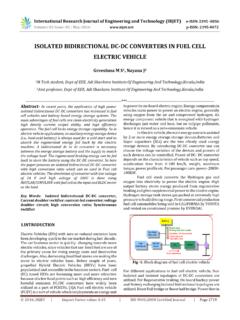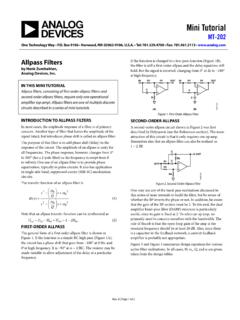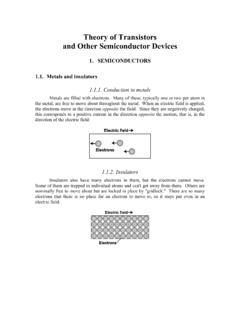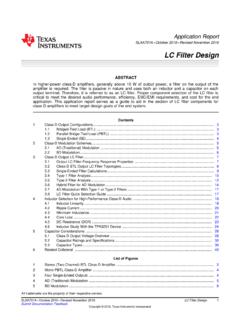Transcription of Design and Construction of 33/11 KV Line & Substation
1 International Research Journal of Engineering and Technology (IRJET) e-ISSN: 2395 -0056 Volume: 03 Issue: 07 | July-2016 p-ISSN: 2395-0072 2016, IRJET ISO 9001:2008 Certified Journal Page 722 Design and Construction of 33/11 KV Line & Substation Mohammad Sharique Nawaz Guide- Prof. Irfan Khan M Tech. Scholar, Electrical and Electronics Engineering Department, AISECT UNIVERSITY Bhopal, MP, India. ABSTRACT - The thesis deals with the analysis of Construction of Power Lines and Substation Switchyard of 33/11 KV. In today s life electricity plays a very vital role. The demand of electricity is being increased day by day. Therefore many new projects are being introduced not only in town as well as in remote areas also to provide the facilities of electricity by Constructing new transmission lines and Switchyard.
2 1. INTRODUCTION Before Construction of any line, survey is done. The Line route should be so selected that the maintenance is easy and the line does not cause Obstruction to vehicular traffic and should be shortest, as well, consistent with engineering and economic principles. The transmission lines shall be routed, where ever possible to avoid difficult terrain and natural obstacles such as steep hills, dense forests, landslides, lakes, rivers, highly developed areas, etc. Transmission lines should not also cross school-yards. The correct and accurate Survey results in speedy Construction and saving of unnecessary alignment and realignment at the time of carrying out actual Construction work. All measurements should be taken with utmost accuracy and similarly the line charts and the profiles should be prepared with great care and precaution. Where the lines are constructed over farm-land, structures and anchors shall be so located as to interfere as little as possible with farming operation.
3 Wherever such structures and anchors become necessary, the same shall be located along fencing or in any uncultivated areas. While aligning for poles or for underground cabling, care should be exercised to determine the location of all underground services such as water mains, sewers, telephone cables, power cables, land drainage tiles, gas, and oil pipe lines etc. and adequate clearance should be provided to avoid damage. The Transmission lines shall be routed to avoid buildings and build up areas wherever possible. The clearances of the various conductors from the ground and buildings should be taken well as per latest INDIAN ELECTRICITY RULES. Where Switchyard means collection of equipment where high voltage electricity is switched using of various components. Electrical Switchyard is usually a part of Substation where electricity is transferred from one Voltage to another for the Transmission and Distribution purpose.
4 2. CONFIGURATION Lines The transmission lines shall be routed to avoid length of parallelism between power and Communication circuits as far as possible. Minimum separation distance between power and Communication Circuits should be kept as 61 metres (200 ft.) for 33 KV line provided length of parallelism does not exceed Km. For greater distances minimum separation distance will be governed by given formula as:- Minimum Spacing = 025 x Metres Where, E = Voltage between Phases in Volts L = Length of Parallelism in Km After the survey and stacking out have been done, the Construction of line should be started. The holes for cross-arm, F- bracket and other fitting should be drilled in the supports before these are transmitted to site. The sequence of operation in Construction of the transmission line is given as:- International Research Journal of Engineering and Technology (IRJET) e-ISSN: 2395 -0056 Volume: 03 Issue: 07 | July-2016 p-ISSN: 2395-0072 2016, IRJET ISO 9001:2008 Certified Journal Page 723 Pit digging and Pole erection Concreting of Poles.
5 Staying of Supports. Running and tensioning of conductors. Clamping up. Fitting of Armour rods and Binding of Conductors. Fixing of Danger and number Plates and Anti-Climbing device. After the line is erected, pole to pole inspection is done to ensure the following:- Jumpering has been done neatly at all the section Points. Danger and number Plates and Anti-Climbing devices has been provided on the supports. Stays provided at angle and section points have been tightened and are taking up the load. All the cross-arms and poles are painted. All the poles are in vertical position. No loose conductor, binding wire or earth wire is hanging at any location and short circuiting the line. All the trees in the danger zone have been felled. After inspection, the line is meggered by 1000 volt megger and insulation resistance between phases and, between phase and earth is noted. Switchyard Switchyard means collection of equipment where high voltage electricity is switched using of various components.
6 Electrical Switchyard is usually a part of Substation where electricity is transferred from one Voltage to another for the Transmission and Distribution Fig-1: Switchyard Equipments TRANSFORMER BUS-ISOLATOR POST-INSULATOR BUS-BAR LINE-ISOLATOR TERMINAL GANTRY International Research Journal of Engineering and Technology (IRJET) e-ISSN: 2395 -0056 Volume: 03 Issue: 07 | July-2016 p-ISSN: 2395-0072 2016, IRJET ISO 9001:2008 Certified Journal Page 724 Switchyard is constructed with assembling of much electrical equipment. The various main structures used in Construction of switchyard are configurations of equipments are:- Transformer, , CT, VCB, Bus Isolator, Post Insulator, Bus-bar, , Line Isolator and Terminal Gantry.
7 The sequence of Equipments used in switchyard from starting point of transformer to the end point of terminal gantry is given as:- 3. PRINCIPLE OF EQUIPMENTS Transformer - A static electrical machine used for transforming power from one circuit to another circuit without changing frequency is termed as power transformer. The transformers are generally used to step down or step up the voltage levels of a system for transmission and generation purpose. These transformers are classified into different types based on their Design , utilization purpose, installation methods, and so on. Lightning Arrester- The Substation equipments such as conductors, transformers, etc., are always erected outdoor. Whenever light surges occur then, a high-voltage pass through these electrical components causing damage to them (either temporary or permanent damage based on the amount of voltage surge). Therefore, to avoid this difficulty, lightening arresters are placed to pass the entire lightening surges to earth.
8 There are other arresters which are used to ground the switching surges called as surge arresters. Current Transformer - It is used for the measurement of the alternating current by taking samples of the higher currents of the system. These reduced samples are in accurate proportions with the actual high currents of the system. These are used for installation and maintenance of the current relays in substations for protection purpose which are normally has low-current ratings for their operation. Vacuum Circuit Breaker - For the protection of Substation and its components from the over currents or over load due to short circuit or any other fault the faulty section is disconnected from the healthy section either manually or automatically. If once the fault is rectified, then again the original circuit can be rebuilt by manually or automatically. Different types of circuit breakers are designed based on different criteria and usage.
9 But in general mostly used circuit breakers are Oil circuit breaker, Air circuit breaker, SF6 circuit breaker, Vacuum Circuit Breaker, and so on. Bus Isolator - These have three stacks of post insulators. The central post insulator carries a tubular or flat male contact which can be rotated horizontally with rotation of central post insulator. This rod type contact is also called moving contact. The female type contacts are fixed on the top of the other post insulators which fitted at both sides of the central post insulator. The female contacts are generally in the form of spring loaded figure contacts. The rotational movement of male contact causes to come itself into female contacts and isolators becomes closed. The rotation of male contact in opposite direction make to it out from female contacts and isolators becomes open. Rotation of the central post insulator is done by a driving lever mechanism at the base of the post insulator and it connected to operating handle (in case of hand operation) or motor (in case of motorized operation) of the isolator through a mechanical tie rod.
10 Post Insulator - It is more or less similar to Pin insulator but former is suitable for higher voltage application. Post insulator has higher numbers of petticoats and has greater height. This type of insulator can be mounted on supporting structure horizontally as well as vertically. The insulator is made of one piece of porcelain but has fixing clamp arrangement are in both top and bottom end. International Research Journal of Engineering and Technology (IRJET) e-ISSN: 2395 -0056 Volume: 03 Issue: 07 | July-2016 p-ISSN: 2395-0072 2016, IRJET ISO 9001:2008 Certified Journal Page 725 ` Post Type insulators are usually used in substations. These insulators are constructed in the form of a cylinder.
















